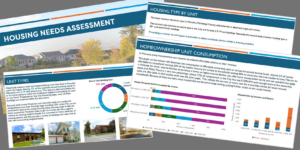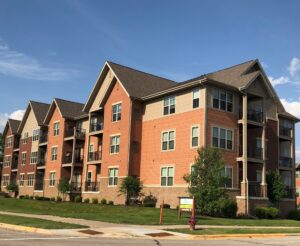There are many tools available to communities to address market rate and workforce housing needs.
These include financial tools such as tax increment financing, tax abatement, grant programs to improve housing conditions, establishing land banks and trusts, and land use policy tools like zoning code changes to allow for more workforce housing, smaller minimum lot sizes, and permitting accessory dwelling units.
Adopting a housing needs study establishes the basis and research for adopting such policies to maintain or increase housing stock for existing and future residents. A housing needs study presents an in-depth look at a community’s housing conditions, market, and needs. Although national discourse portrays housing affordability as a universal crisis, MSA knows that every community is unique, having distinct needs dependent upon economic and social conditions. A housing needs study examines these unique conditions and proposes ideas for how housing needs can best be met.

Tools and Strategies for Addressing Housing Needs
Funding Tools
There is a wide array of funding tools to implement housing strategies for both market rate and workforce housing. This includes local financing tools like tax increment financing, tax abatement, federal grant programs such as Community Development Block Grant (CDBG), U.S. Department of Agriculture Rural Development (USDA-RD), and the National Housing Trust Fund (HTF).
Tax Increment Financing (TIF): TIF is a public financing method used to subsidize redevelopment, infrastructure, and other community improvement projects. It helps fund housing projects without directly increasing taxes by capturing the increase in property tax revenues from new development within a defined geographical area. Common TIF-funded projects include:

-
- Redevelopment of substandard, obsolete, or vacant buildings
- Financing public infrastructure improvements (e.g. streets, sewer, water)
- Environmental cleanup
- Rehabilitation of historic properties
- Providing direct development incentive (Illinois, Minnesota, and Wisconsin)
Tax Abatement (not applicable to Wisconsin): Tax abatement refers to a reduction or elimination of taxes, fees, or penalties that a property owner would otherwise owe. In the context of property taxes, abatement can mean a temporary reduction or exemption from property taxes for a specific period. This is often used as an incentive to encourage development, renovation, or investment in certain areas or types of projects, such as affordable housing. For example, a city might offer a property tax abatement to developers who build affordable housing units. This means the developers would pay reduced property taxes (or none at all) for a set number of years, making the project more financially viable.
Grants for Housing Improvement: Applying for state and federal grants to improve housing conditions can provide funding for renovating existing housing, building new affordable housing, or supporting housing programs. This can help in addressing housing quality and affordability issues. Some grants include CDBG/HOME, the National Housing Trust Fund, and the USDA Rural Development (RD) grants.
Local Housing Strategies
Land Banks: Land banks are public entities that acquire, manage, and repurpose vacant, abandoned, and foreclosed properties to stabilize neighborhoods, reduce blight, and create opportunities for new housing and community development. They acquire properties through tax foreclosures, donations, and purchases, manage them to prevent further deterioration, and repurpose them for community benefit. Land banks help increase property values, reduce crime, and contribute to local economic growth by transforming neglected properties into valuable assets. They often have unique powers, such as extinguishing liens and holding properties tax-exempt, to facilitate their work.
Community Land Trusts: Community Land Trusts (CLTs) are nonprofit organizations that acquire and hold land to ensure long-term affordability and community control over land use. They focus on creating and preserving affordable housing by separating the ownership of land from the ownership of buildings on the land. This helps keep housing costs low and prevents displacement. CLTs typically use ground leases to maintain control over the land and ensure that it is used for community benefit.
Accessory Dwelling Units (ADUs): Allowing ADUs such as “granny flats” or basement apartments can increase housing options within existing neighborhoods and create additional income for residents. This can provide affordable housing options and increase density without significant changes to the community’s character.

Zoning Code Changes: Changing zoning codes to allow for more workforce housing can help in creating affordable housing options for low- and moderate-income workers. This can include allowing higher-density housing or mixed-use developments. Some examples of zoning changes include amending or creating districts to allow smaller minimum lot sizes and setbacks, reducing parking requirements, increasing maximum building heights, allowing more types of housing, streamlining approval processes, and allowing small-scale multi-unit developments.
Adaptive Reuse: Adaptive reuse is the process of repurposing old or underutilized buildings for new uses, while retaining their historic or architectural features. This approach not only preserves the cultural heritage of a structure but also promotes sustainability by reducing the need for new construction and minimizing waste. It’s a creative way to breathe new life into existing spaces, transforming them into vibrant, functional assets for the community.

The Role of Housing Studies in Community Planning
It is one thing to be aware of the tools available to improve the local housing market, but it is hard to know how to use these tools effectively. The primary role of a housing needs study is to identify needs and solutions that will work for your community. Well-prepared housing studies provide communities with:
- Projections of future demographics — helping a community to anticipate changes in population size, age distribution, and household composition.
- Evaluation of the conditions of the community’s existing housing stock to understand the adequacy of existing housing and identify areas that require renovation or replacement.
- Analysis of the affordability of housing in the area, considering income levels and housing costs.
- Historical trends in the housing market, including prices, sales, and rental rates.
- A review of existing policies and regulations that affect housing development and identifies potential changes to support the community’s housing goals (e.g., zoning code changes, TIF assistance policies).
- Determination of community needs and preferences through surveys and public participation events.
- Identified gaps in the housing market by comparing current housing supply with projected demand.
- Identified areas suitable for new or infill development including underutilized land, vacant properties, or areas that can support higher-density housing.
- List of eligible funding sources available to a community based on state statutes and income eligibility.
Conclusion
Housing studies and needs assessments are essential tools for communities to understand their unique housing challenges and opportunities. By providing detailed insights into current and future housing needs, these studies help communities develop effective strategies to ensure that all residents have access to safe, affordable, and suitable housing. Through the use of various tools and strategies, communities can address housing shortages, improve housing conditions, and create vibrant, inclusive neighborhoods. Contact MSA to start a conversation about your community’s unique housing needs and challenges.
